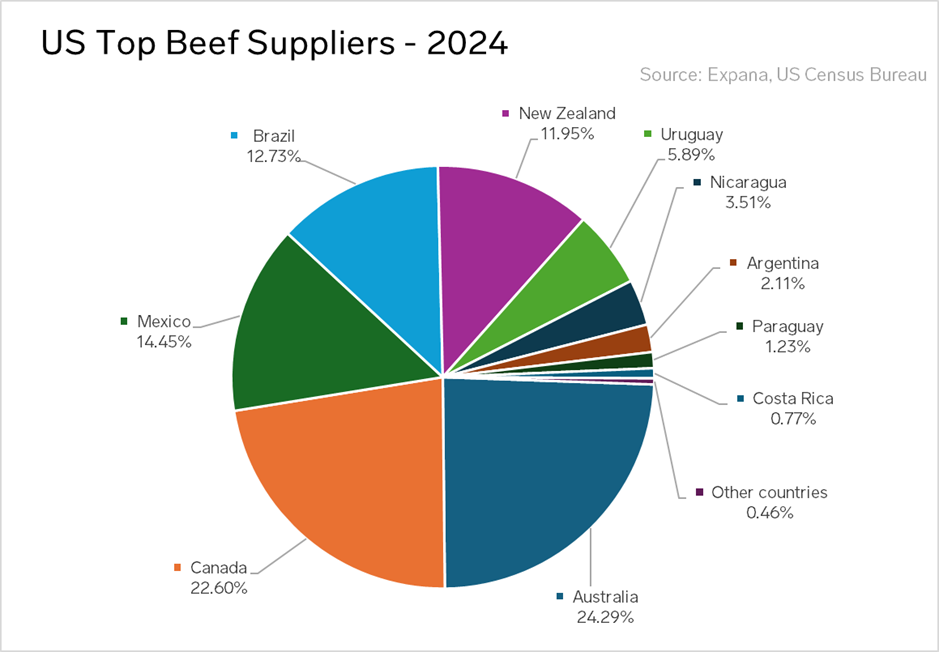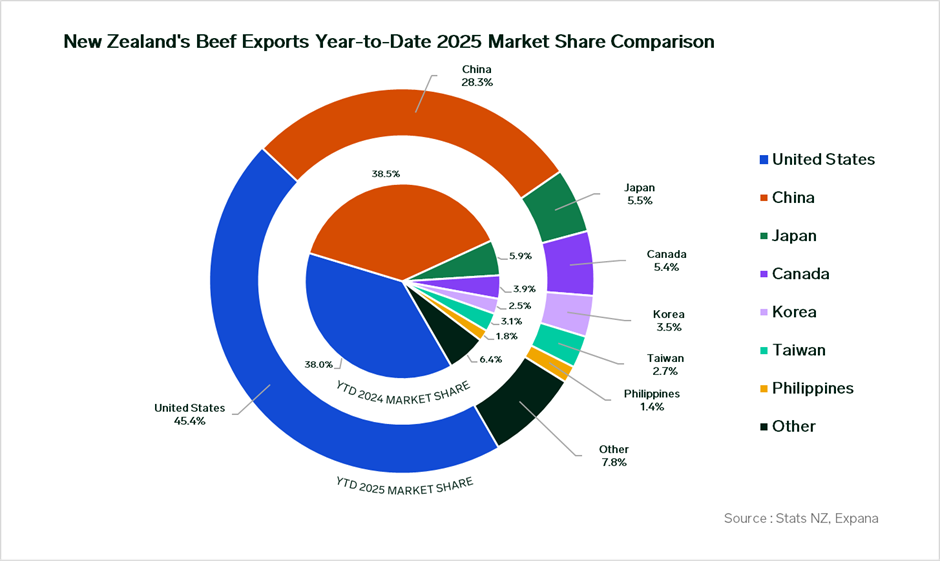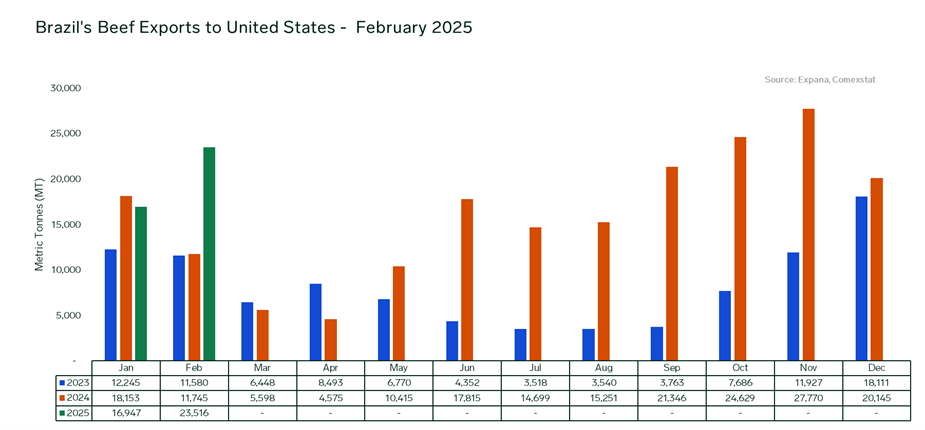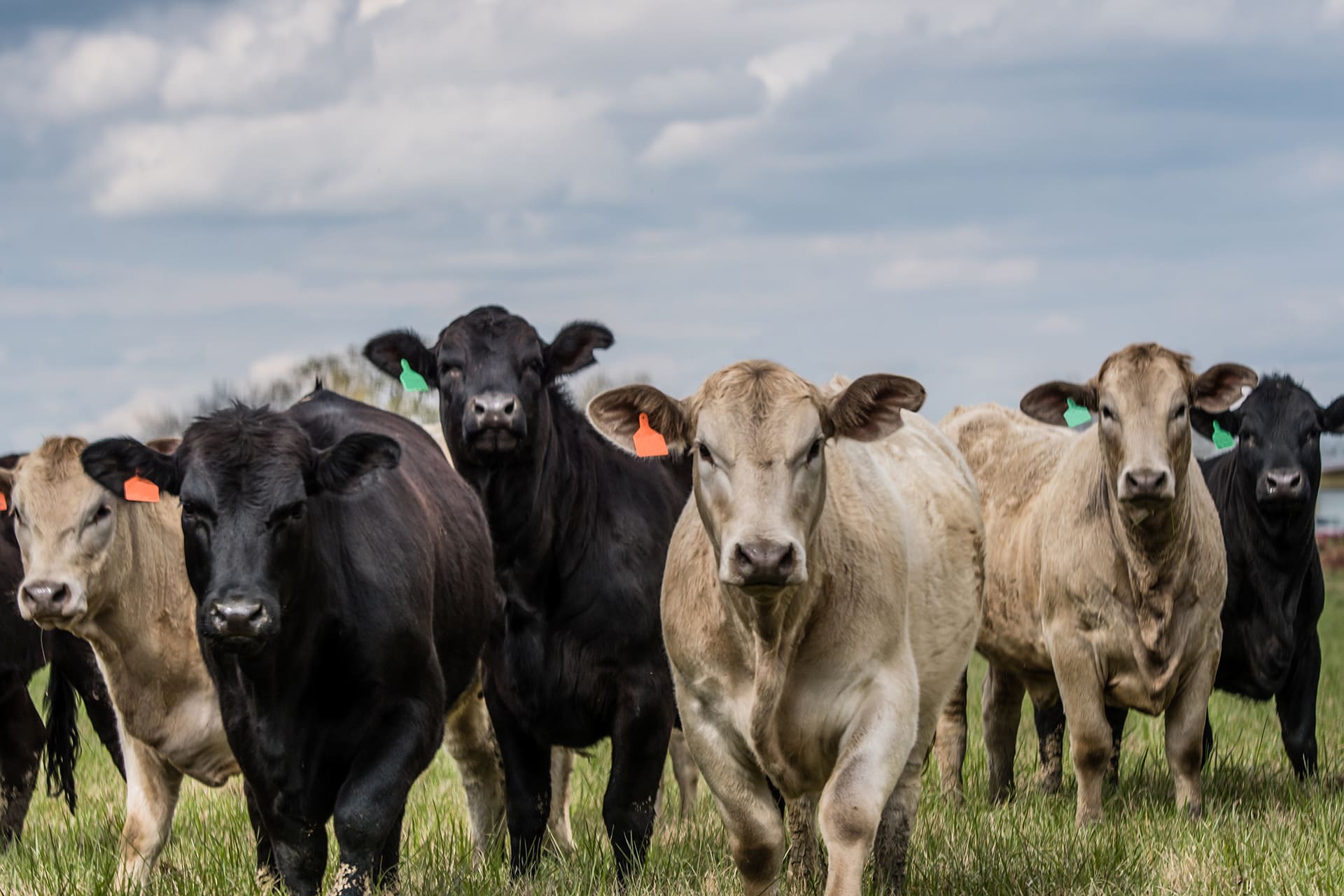On the second day of April 2025, President Donald Trump has declared tariffs on the United States (US) trading partners worldwide.
Our global red meat beef team brings you the latest updates from all key exporting countries and the effects on the imported beef market in this analysis piece. In this article, we weigh the impact of the new 10% baseline tariff on US imports, set to take effect from April 5.
US Import Market

| Tariff changes | Share of US Beef Imports affected |
| 0% | 36.9% |
| 10% | 58.7% |
| 18% | 3.5% |
| 20% | 0.3% |
| 24% | 0.1% |
Tariffs imposed on the imported lean beef segment can impact the entire supply chain given its market inelasticity.
The additional tariffs announced yesterday ranged from 10% – 18%. When compared to competing US domestic beef, the discount in the market generally exceeds the additional tariff rate, meaning that users of imported beef may still opt for imported product. There has been some talk that participants throughout the value chain, from cattle producers to the ultimate consumer, may potentially absorb a portion of the new tariff.
*Mexico is under USFMA, and is exempt from the 10% tariff
The US market relies heavily on imported leaner boneless beef, which is essential for blending with the US’s grain-fed fattier trimmings to produce ground beef and processed products. This is especially true as the warmer weather approaches, when burgers and sausages are staple elements of the classic summer barbecue. Common lean-to-fat ratios in these finished products can run anywhere from the mid 70% to as much as 95% lean, balancing flavor, juiciness, and leanness to meet diverse consumer preferences.
While countries like Australia, New Zealand, and Brazil are likely to still provide the lion’s share of this leaner beef requirements, the tariff hike has reduced their price advantage. A different cost structure that includes the new tariffs could reduce their price competitiveness to US domestic product.
Owing to its free trade agreement (FTA) with the US, Mexico’s price competitiveness falls within the median range. However, its predominantly fattier trimmings are less desirable to the US market’s blending needs.
Other smaller niche Central American suppliers such as Costa Rica and Nicaragua could have some price advantages compared to other key suppliers, but its small market share would limit a large-scale market shift.
Australia and New Zealand
Australia and New Zealand beef exporters are keenly watching the market developments as it unpacks.
While the newly added baseline tariff reduces competitiveness in the US market, most industry players believe the market impact will likely be ‘manageable’ in the mid-to-long term, with some having initially feared a steeper hike. Despite the tariff, exporters argued that the US will remain a key buyer, with current cold storage beef stocks are historically low.
Market participants anticipate the additional cost could be absorbed incrementally along the supply chain.

Exporters Down Under also pointed to their experience navigating similar tariff challenges in the European Union (EU) and other export markets, minimizing any immediate disruption.
Both the Australian and New Zealand governing bodies (customer access only) had put out statements respectively, ranging from seeking negotiations to seeing opportunities opening in other markets.
Some short-term price adjustments and resistance from traders may occur in the coming weeks, but the broader trade flow is unlikely to be significantly affected, sources added.
The Oceanic market is currently also focused on supply concerns, with severe livestock losses in Queensland due to flooding and heavy rains disrupting production in New Zealand.

Brazil
Brazil exporters may face a greater challenge, with the new tariff adding 10% on top of its existing 26.4% Most-Favored Nation (MFN) rate. In 2025, Brazil helped to exhaust “other countries” quota of 65,000 mt in just 17 days.
This raises questions about whether Brazilian beef prices will still be competitive at this higher rate or if South American suppliers will redirect more product to its other key markets such as China.
However, its production boom and large scales of economies still provide ample opportunities for the South American titan to capitalize on the lean boneless beef the US market needs.
For now, Brazil exporters remain cautiously optimistic regarding the fast-changing tariff landscape and aim to continue expanding its market share in the US and other regions.

Canada and Mexico
Canadian and Mexican cattle and beef remain exempt from tariffs, thanks to the United States-Mexico-Canada Agreement (USMCA).
Over the past decade, the US has imported an average of approximately 1.93 million head of cattle from its closest neighbors, Canada and Mexico, ensuring a steady stream of beef supply. This steady influx of cattle helps to meet US domestic beef demand. These cattle are eventually sold as live cattle, with their beef becoming a vital part of the US domestic fresh product supply chain.
Canada and Mexico accounted for roughly 37% of total beef imports into the US in 2024. Typically, these countries send beef cuts to the US. The boneless items that are sold to the US are usually fatter trimmings.
As trade for these items remains exempt from tariffs under this latest announcement, the lower costs could prompt the US market to purchase more from its closest neighbors. However, Canada and Mexico primarily export fattier trimmings, which does not align perfectly with current US demand for leaner cuts, the price advantage could only make their offerings attractive to a smaller extent.
The Rest of the World
Reactions from other key Asian markets are still unfolding. While Japan and Korea primarily serve as beef importers, their domestic Wagyu and Hanwoo markets remain largely insulated from major shifts. However, there are indications that China, Japan, and Korea may issue a joint response, with Beijing already urging Washington to drop the tariff as soon as possible.
Other Southeast Asian markets are reviewing the situation, though Australia’s dominance in the region’s beef supply suggests a limited direct impact.
For now, while adjustments are occurring, all key beef exporters aim to remain resilient, focusing on mitigating challenges and maintaining trade with the US.
To gain a deeper understanding of the tariffs’ impact on trade flows, read our latest global team report: The Shadow Impact: How Tariffs Reshape Beef Trade in the US and Beyond
Authored by:
Augusto Eto
Expana
+55 41 99949-9700
[email protected]
Bill Smith
Expana
732-575-1977
[email protected]
Emily Schlichtig
Expana
1-732-240-5330 ext 245
[email protected]
Joe Muldowney
Expana
1-732-240-5330 ext. 244
[email protected]
Junie Lin
Expana
[email protected]


